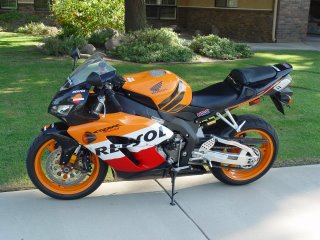Search This Blog
Tuesday, December 19, 2006
Where the satellites are...
http://science.nasa.gov/realtime/jtrack/3d/JTrack3D.html/
A window will pop up and ask you if you want to run it. Click yes. You will get a real-time display of all the satellites orbiting the earth. The ring of satellites is the ones in geosynchronous orbit - they stay in the same place in the sky so that you can aim your DirectTV dish once and then forget about it.
You can zoom in and out on the earth and roll it around to find where you are at. Of greater interest is that you can click on a satellite and see its orbit. If you happen to be out shortly after sundown or just before sunup, you can look to see if you can watch a flyover. This is when the sky will be dark, but the satellite will still be illuminated by direct sunlight. It's very cool to watch.
Anyway, it's a cute program and I like to fire it up from time to time.
UPDATE:
Well crap - that's another great website that's gone for good. Anyone know of another one?
Monday, December 18, 2006
Polonium 210
The political ramifications are a bit beyond my understanding, other than the obvious consideration that someone was bold enough to assassinate a political enemy on foreign soil.
Why instead of radioactive poison didn't they just shoot him, disappear him, or run him over? Curious stuff...
What I find fascinating about this case is the technical challenges and genius at the nature of the poisoning, as well as the choice of the radionuclide, Polonium 210 (or Po-210 for those in the nuclear biz).
I've done a bit of reading on Po-210 since the news of Litvinenko's poisoning hit the wires. It's quite an interesting and quirky nuclide.
Let me start by sharing a little about radioactive decay. There are four basic decay mechanisms for radioactive nuclei, each with distinct mechanisms for releasing the energy of decay. As the mechanisms are distinct, so must be the means for detecting them.
Gamma rays are ubiquitous. These are elecromagnetic waves with very short wavelengths, somewhat shorter than hard x-rays. Gamma rays are usually associated with a neutron decaying to a proton and an electron, or just being fired out of an unstable nucleus. 90-95% of all decays release a gamma ray, and it's probably responsible for most of the background radiation everyone is exposed to, either indirectly from cosmic rays, or naturally occurring radioactive elements.
Biological damage due to gamma rays is not bad, as these things go. They create ions by photoelectric effect, pair production, or by compton scattering. The upshot is that charged electrons (or positrons) are knocked loose and are available to ionize (damage) internal tissues. I think of these as little BB gun shots. A few are not so bad, but a shotgun blast of them is quite harmful. Gamma rays have a biological damage factor of x 1
Sheilding: High density metals are best at absorbing gamma rays. The greater density of the metal increases the likelihood of the above interactions attenuating the gamma ray before it reaches you. The amount of sheilding required depends on the intensity (decays per second), and incident energy of the gamma rays.
Detection: Exept for the weakest gamma rays, which are rare, gamma is easily detected. A simple geiger detector can identify an energetic gamma emitter 10-20 feet away.
Beta particles (also known as electron emission) are also ubiquitous. Most of the known decay mechanisms are beta decays, and are usually accompanied by a gamma ray. Beta emissions are mostly associated with the two highly unstable nuclei remaining after a heavy nucleus is split (fissioned).
ASIDE: The highly radioactive spent fuel from nuclear plants undergoes a phenomenal amount of beta/gamma activity. In fact these unstable fission products generate about 7% of the heat of a reactor at full power immediately after it has been shut down. This heat tapers off over the course of several weeks, but without cooling, this decay heat can melt the a reactor core long after it's been shut down.
Back to beta particles. They are basically exceedingly fast-moving electrons, and because gamma rays cause damage by creating these particles, their biological damage mechanism and severity are the same, x 1.
Sheilding: Beta particles have quite a bit of penetrating power, though nowhere near the power of gamma rays. A 1/4 inch sheet of aluminum is the textbook example of what will stop beta particles from reaching you. Obviously this approach will not work if the beta emitter has entered your body.
Detection: Beta particles are easier to detect than gamma. A gamma ray can pass right through a geiger detector without interacting with a molecule of the gas. A charged beta particle is quite likely to have several interactions as it passes through the gas.
Neutrons: These particles are rare, except within the confines of a nuclear reactor, so I won't go into them in depth. I did want to mention them, as they are what cause atoms to become radioactive, (e.g. emit alpha, beta, and gamma radiation) and cause them to fission. This is important, because this part of what makes the Polonium 210 story so interesting.
Alpha particles are most often associated with heavy nuclei (think Radium, Thorium, Uranium, Radon). An unstable heavy nucleus usually kicks out an Alpha particle and a gamma ray as it seeks a lower (more stable) energy level. The alpha particle is actually just a helium nucleus (two neutrons and two protons), that dropped the electrons as it was blasted out of the nucleus.
Here's what's bad about alpha particles biologically: They have a large +2 electrical charge, and compared to the other decay particles, they are massive. Due to their mass and charge, they ionize tissue quite readily, doing a great deal of damage. In many respects, they are like little nuclear hollow-point bullets. They do not penetrate very far in skin tissue or in air, but are lethal when taken internally.
Sheilding: In general an alpha particle can be blocked by a piece of paper. Taken internally, there is nothing to prevent an alpha-emitter from doing truly massive damage. Alpha particles have a biological damage factor of x 20.
Detection of alpha emitters is not normally difficult. Since most nuclides emit a high energy gamma ray at the same time as the alpha particle, the gamma ray gives away the presence of a radionuclide. Interetingly Po-210 is one of the few alpha-emitters that does not emit a gamma ray during decay. Direct detection of alpha particles is more difficult; due to their large charge, they tend to come to have very short flight paths, even in air. Detectors must have thin windows (mylar) and be very close to the source. Geiger detectors and scintillation counters in close proximity to the source are your best bet for detection of alpha particles
Now that we have the primer on radiation, sheilding, biological damage, and detection taken care of, lets look at how Litvinenko was poisoned:
1) Polonium-210 is an alpha emitter that has a half-life of about 138 days. That means that 138 days after you take it from a reactor, only half will remain, after another 138 days you'll only have 1/4 of it, then 1/8, 1/16, etc, etc. There is no gamma ray associated with this decay.
2) Polonium is exceedingly chemically toxic. Weight-for-weight, polonium is around 5 million times more toxic than hydrogen cyanide, the gas used in state's gas chambers. 50 nanograms will kill 50% of those exposed to it. It accumulates in the liver and spleen where it chemically attacks them.
So what can we deduce about the poisoners' technological infrastructure from the above information?
They have a nuclear reactor (or access to freshly spent nuclear fuel) to even produce Po-210.
They have access to a hot cell which gives them the ability to remotely handle and chemically process highly radioactive spent nuclear fuel to separate the Polonium.
They realize that once the Polonium 210 is ingested, the victim's body will act as a shield to prevent alpha particles from reaching external radiation detectors. No gamma rays will give away the existence of the Polonium.
They understand that the dose of Polonium 210 will kill Litvinenko either chemically or due to the the alpha radiation effects.
Which leaves us with the question of who did it... all I can say for certain is that they have highly developed nuclear technology: Nuclear reactor, fuel handling, and isotope separation. There are a handful of countries and companies that could do this, but only one that had all of that plus a grudge ;)
Yahoo Searches
From Yahoo:
Top Searches of 2006
By Mike Krumboltz
Fri, December 08, 2006, 3:40 pm PST
"Yahoo! users searched on all sorts of stories this year, but Britney was the biggest of them all. Despite (or perhaps thanks to) her trainwreck of a personal life, Ms. Spears took home the title of Yahoo's top search of 2006.
While the former Mrs. Federline may have been the most popular, she was far from Search's only story. "American Idol" dominated as expected, the untimely death of Steve Irwin shocked us all, and the Iraq war remained on the minds of many."
I've never really given a damn about celebrities - I don't attach any more importance to their lives than anyone else's. Perhaps less so in in the case of "Idol", Britney and Irwin. Idol and Britney are without substance, and Irwin spent a lot of time provoking wild animals to further his career. It finally caught up with him. His crocs likely would have been happier and better off in their natural surroundings.
That the Iraq war is #4 on the list behind these others isn't surprising. What is surprising is that this horrific event made the top 5. Amazing how ill-informed we are as a nation. With all the information of the world available on a PC, we use it to see what the tabloids are saying in real-time about Britney... and so I'm happy to say I'm not a well-adjusted member of this society ;)
Saturday, December 09, 2006
Favorite quotes
"Everybody wanna be big, but ain't nobody wanna lift no heavy-ass weights." - Ronnie Coleman
"Only two things are infinite; human stupidity and the universe. And I'm not certain about the latter." - Einstein allegedly said this.
"Two things a man should never be angry at: Those things he cannot change, and those things which he can" - Unknown
"Never take a crap until you get on the clock. Don't break a sweat until you are off the clock. Never get your pussy and your paycheck from the same place" - Blue collar worker's axioms.
"In theory, theory and practice are the same; in practice, they're not" - Yogi Berra allegedly said this.
"A man with one watch always knows what time it is. A man with two watches is never certain" Unknown.
"Economic history is a never-ending series of episodes based on falsehoods and lies, not truths. It represents the path to big money. The object is to recognize the trend whose premise is false, ride that trend and step off before it is discredited." - George Soros
"Hyperbaric surgery (gastric bypass) is the biggest cop-out since suicide was invented." - unknown
Monday, December 04, 2006
Toys for tots and long wheelies
After the ride there was a barbeque and sodas were served. It gave me an opportunity to meet some previously unknown sport bike riders, a few of whom also happen to be stunters. The are a group known as the 'bako boyz'.
They have a website that has some pretty wild video clips. Their tutorial "Guide to Wheelies" is a tongue in cheek howler.
The guy we got talking to, named Chris, was quite friendly and outgoing. Toward the end of the gathering, he said "I feel like doing a wheelie". I said "I feel like watching that!" So we all got on our bikes and got the tires warmed up for a few minutes, then he took it out on the freeway, slowed to 45 mph, and popped it up on one wheel and rode for about half a mile. Then he did a stand-up wheelie for us. Cool! Chris BTW is in the video link above, riding the lime-green bike.
Then he told me to do one. So I did a little one - there's a point (well shy of the balance point) where the front wheel really starts lifting quickly, which is where I always back way off and let it drop. He suggested that I back off less and try to find the balance point. And I said, well it's the consequences of not getting it right that scares me the most :) He laughed and we agreed to meet at one of their gatherings soon. Nice guy - really outgoing and likeable. Engaging and fun.
He did mention that once you learn to ride a wheelie you won't be able to stop doing them... He's probably right. I find myself getting bored commuting to work and wanting to blast off real fast or take a corner or something... anything. There's something about having a 400lb vehicle with 150 horsepower that makes you want to use it in excessive ways.
Speaking of which, at one point I was riding quite tamely in heavy traffic, but letting the bike rev a bit over 5000 RPM (about half of what it's capable of), when this little Toyota next to me apparently thought I meant to race. So he stomped on the gas and lurched ahead of me. I didn't bother to snap the throttle open, as I was laughing so hard I nearly peed myself. Unless that Toyota sedan was able to go 0-100 in 5 seconds (something that Ferraris can't do), then he was wasting his gas.
Saturday, December 02, 2006
Guitars
In the early nineties I was probably at my best, and tried out for a small garage band. Nervous as all hell (with an uncritical audience of four, hahaha), I didn't perform very well. And not having played much since then, you might call me "Rusty".
But what this post is really about is the guitars I've owned in the past, the guitar I have now, and the ones I'd like to have in the future.
The first one:

A white fender Stratocaster or just "strat". As built, these have three single-coil pickups and a five position selector switch so that you can use any pickup by itself or get a dual input from any two adjacent coils, for a sort of phasing effect. To my ear, selecting two pickups seemed to "muddy" the sound.
I nearly always prefer the bottom pickup, the one closest to the bridge. This is the one that gives that classic biting high and clear Fender sound. Pink Floyd and Clapton solos are a vivid example of the awesome sound these guitars are capable of in the right hands. Man, I think I'm gonna play Floyd's "Wish you Were Here" album whilst I continue to write... ah man. That's almost giving me a buzz! :)
Back to the white strat though. I never did like it much. The intonation wouldn't hold. I don't think that particular one was very good quality. To make it right would have taken quite a bit of expensive professional work and money that I didn't have. In any event I was just a beginner and didn't feel such a big invesment had much merit. So I sold it.
I've since played Strats in stores, and friend's instruments. I liked them better, but never quite as much as the sunburst colored Les Paul, which was the next guitar I bought.

I liked the way this guitar played a lot! It had a nice wide neck that let my fat fingers hit the strings without touching the other strings. That's a good thing if you want to play chords without strings buzzing on you.
What I didn't care for too much about it was the muffled sound. As built, these guitars come with "hum-bucking" pickups, which have dual coils wound counter to one another to cancel out the hum you get feeding back from some amps. A very clean sound, but to my ears it sounds quite muddy. Jeff Beck favors these guitars (kicks butt with them!!!), and I think they're great rhythm instruments. I probably should get another one, because I'm never going to be a great solo player.
The third guitar, a 1985 or 86 sunburst-colored Telecaster "tele" - has a fascinating story.

This guitar has an interesting background. One afternoon while I was still in the Navy and the submarine was in port, my roomate Buff (Big Ugly Fat F**ker - yes he liked to be called that) and I were getting drunk. This was not so unusual. What was unsual was that I decided that I needed a guitar and that he needed to learn how to play the Bass :) Unfortunately for him, he needed no persuasion whatsoever, so we went to a used music store on Broadway street in San Diego. The place had a feel very similar to the famous Ray Charles scene in the Blues Brothers. Back in the 80's, Broadway was quite seedy.
I loved this guitar! Man that thing could ring clear and true and hold a note forever.
Me and Buff spent a lot of time practicing together and actually had guys interested in playing/singing with us! Then I got out of the Navy and we drifted apart. Shortly after this, I got out of the Navy and moved to La Jolla and into an apartment with a guy who'd gotten out a few months earlier... (I'll do a long post on him later - he's an important person in my life).
I ended up meeting a neighbor who worked in construction who also played the guitar. He showed me some interesting licks, and I showed him a few that I'd picked up over the years. I wento over to his apartment and we played together a few times. He was very, very good - which caused me to become discouraged. I was ready to quit, and told him so. (He played a Les Paul) He offered to buy the Tele from me, and I agreed.
15 years later my roommate ran into the guy I'd sold the guitar to. He asked how he was doing. Turns out he was no longer working in construction and was making money as a professional musician. His name is Dean DeLeo. He's the guitarist for the Stone Temple Pilots. I want my damn guitar back... signed :)
The guitar currently own was purchased new down on Sunset strip in Los Angeles. It's a 1990 black tele. I love it except for the color. Teles are frequently used in the new country music scene, much to my dismay. This is a genre of music that's a little too formula for my liking. Johnny Cash and Hank Williams are probably spinning in his graves over what 'country' music has become.
Moving on now to Floyd's "The Division Bell" Friggin' awesome.

My current amp: A Fender Twin Reverb. Cool classic sound. And I have a Morley Fuzz-Wah pedal for when I attempt to play Tocatta and Fugue.

Guitars that I'd like to have someday:
#1 A Rickenbacker 330 or 360 in fireglow color. These are semi-hollow bodied guitars, and give a totally cool sound. Think surf music, or the Byrds. George Harrison played this one. For me, the Romantics "What I like about you" is another example of the classic sound this guitar puts out.
Semi-hollow body guitars look huge to modern eyes, but they have a sound that can't be duplicated by digital signal processors. I think they are fabulous instruments.

#2 on my wish list, The Gibson ES-335 in sunburst color. Another semi-hollow body. BB King made this one famous. I like the sound this one makes. It's clean, if not very biting. I've been to a few jazz concerts and they seem to be favored by the guitarists. I think Spyro Gyra would be a good example of this sound.

All this crap might lead you to think I'm a musician. I'm not. Unfortunately, I don't have natural talent for playing, and have to struggle to learn even the simplest things. But I love music, love guitars, and love playing them.
Friday, December 01, 2006
The THX sound
As an amateur musician (lousy guitarist - no albums, bands, or chicks) I was absolutely fascinated by the sound, and decided to learn more. So with full credit, here is where I learned about the "Deep Note", as it's called in the industry.
Wednesday, November 29, 2006
PC Recovering...
Looks good. Everything works, and the annoying beep I was getting from the case speaker has stopped. Have managed to get Zone Alarm, AVG, and Spyware Blaster running with no problems.
The big ordeal (for me) will be getting Steam up and running. I'll be keeping my fingers (and toes) crossed!
First home-built PC
The machine I just built has the following components, and I've yet to get it working reliably - as I'll explain shortly.
Intel Pentium D 820 at 2.8 Ghz
GA-965P-S3 Gigabyte motherboard
2x1048 800 MHz memory
Two Western Digital 160 MB hard drives
Lite-On 48x (16x) DVD-R
GeForce 7900 PCI-e video card
1.44 Mb floppy - A little retro, but it turns out that I needed it!!!
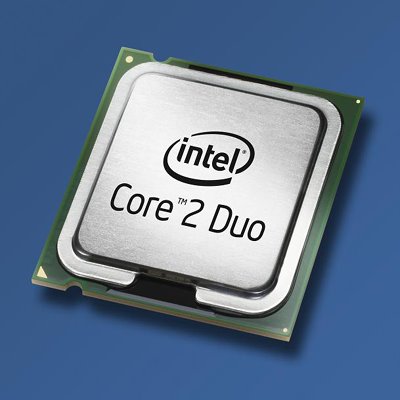
I set up the hard drives to be RAID 1 (mirror image drives), which the motherboard supports. This was not too easy to accomplish - especially since it was my first shot putting a PC together. I had to change the BIOS (something I'd never done), make a floppy boot disc with CD drivers and RAID drivers (something I'd never done), and tell windows to set up the drives as RAID drives (something else I'd never done). It took a long time to figure all this stuff out, and the order in which it has to be done, since there's no step-by-step instruction that incorporates drivers, BIOS and Windows.
Anyhow, I got it all running to where on start-up it said (note the past tense) that it was confgured RAID1 and Windows ran fine.
However... *sigh* It didn't last long. I tied it onto the internet and Windows XP downloaded somthing like 64 updates. I clicked to install them, and the message said it was OK to continue working while Windows updated itself.
So I went about loading freeware firewall, virus, MP3 player, and Steam. That's about the time the PC locked up. Rebooting gave an error message saying that the PC couldn't locate any storage devices. Joy.
So I tried booting from the CD. Got a blue screen of death saying that system_registry was corrupted. Joy again. Couldn't even format the drives.
So I had to go into BIOS and delete the RAID configuration, and set it up as RAID 0 (striped) which *forced* windows to format the new Hard Drive configuration. And I'm in the process of re-loading windows as I type this. If it runs, I'll probably re-format it for RAID 1.
But to be honest, I'd had higher expectations of reliability from a RAID 1 setup Still learning...


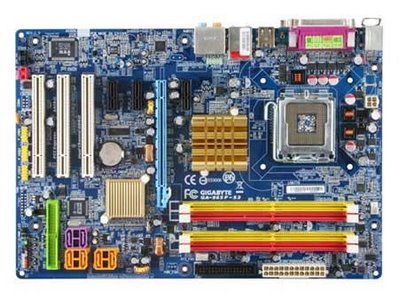
Tuesday, November 28, 2006
Some cool movies I've watched recently
Four Rooms - an absolute howler. Quentin Tarantino wrote portions and stars in it.
Pulp Fiction - nothing I can say about it that hasn't been said already
Trainspotting - different... very different. And it's wierd seeing Ewan MacGregor (The young Obi-Wan Jedi) playing the role of a debased heroin addict.
Fight Club - Awesome!!! Totally cool. I like the single frame subliminal stuff they stuck in there. Highly under-rated.
The Machinist - Awesome again.
Memento - Didn't care for it much. Very difficult to follow.
The Game - Another outstanding flick. Screws with your mind delightfully.
Grosse Point Blank - Funny, but too sappy.
Fargo - Too funny.
High Fidelity - I like John Cusack, but it just wasn't funny enough.
Reservoir Dogs - Grim, but cool.
Snatch - Awesomely funny. Guy Ritchie kicked butt on this film.
Lock stock and two smoking barrels - Funny, but not as good as snatch. Same director.
Very Bad Things - I loved this one! (and felt guilty for enjoying a grisly movie so much)
Panic Room - A bit predictable. I liked Dwight Yoakam as a villain though.
Bad Santa - ... a tough one to laugh at, but it has its moments :)
Pushing tin - same as above.
Monday, November 27, 2006
Peak Oil - is it real?
Economists are funny people. A lot of them seem to believe that the textbook theory of supply and demand translates perfectly into the real world. The reason I mention this is that there seems to be a belief that when crude oil becomes scarce enough, more drilling will occur, increasing the supply - and there's nothing wrong with that, in theory.
The problem is that in practice we are dealing with a finite resource. Ask an economist about the market for dodo bird feathers is doing, and he'll give you a blank look. Adam Smith didn't live in a world of limited resources - he lived in a world of immature industrialization.
With that in mind I found some fascinating charts regarding North Sea oil production at The Oil Drum. This is very thought-provoking stuff! There is a clear double production peak and decline in spite of frenzied exploration and development effort.
The original posting can be found here. I would have re-posted the charts, but the pix wouldn't show up on blogger for some reason :-(
Tuesday, November 21, 2006
Current reading redux
Background:
It's my understanding that all oil fields go through a bell-shaped curve of production. Beyond the peak, production falls off, regardless of how much effort and money are spent. The oil doesn't ever really "run out", it just becomes less plentiful. There are still stripper wells in Pennsylvania, even though it's not the producer it once was...
New techniques and technologies are constantly improving the recoverable oil, but this only delays the inevitable. Furthermore no major fields have been discovered in 50 yrs, and the North Atlantic field developed just 10-15 yrs ago is already in serious decline.
The authors point out that oilfield data from the Saudi government is a state secret. Then they mention that the Saudi oilfields that provide 25% of the worlds supplies are over 50 yrs old, and very mature at this point. The question they ask and attempt to answer, is whether those ageing oil fields are peaking or possibly in decline at this point. That's what's in the forward, which I read last night.
The answer will have grave consequences for our energy-dependent civilization, particularly with regard to personal transportation. Cheap gas may not last much longer. I'll blog more about it as I learn and digest the contents. It certainly sounds plausible...
Sunday, November 19, 2006
Current reading
Luis Alvarez is a personal hero of mine, and to be frank, I don't admire very many people, and not very much. What I admire about him is his boundless sense of curiousity and his incredible ingenenuity at finding ways to satisfy that curiousity.
Luis Alvarez experimentally confirmed the positive charge nature of cosmic rays (highly accelerated nuclei), electron K-capture decay, and meson-catalyzed fusion. He also invented phased-array radar and the first aircraft ground-control landing system. He performed important work in the Manhattan Project, mainly involving the complex triggering mechanism for the plutonium device.
Wandering outside the realm of physics, In conjunction with his son Walter, Luis Alvarez has seemingly solved the mystery of the dinosaur die-off. Their theory of a cosmic impact being responsible for the K/T extinction is widely accepted today.
A great man with a truly great mind.
Blogger Template Beta
An excellent idea, as the content often sucks and the posting frequency is spotty. Hey - it's my blog and I can insult myself if it suits me ;)
Saturday, November 18, 2006
Twilight Zone Stock Market
The links to the right are the ones I trust to be least conflicted about reporting what's really happening in the economy - as opposed to watching CNBC.
Anyhow, I was lying half-asleep the other morning and an odd thought crept into my head about the market and its unusual bouyancy (Dow making new highs) in the face of some very difficult macro conditions (housing meltdown, auto manufacturers collapsing, etc). I say 'odd' because the stock market is not usually something one would expect to be swirling in my cortex at 3:30 AM
Interestingly enough, the bond market and copper futures are unmistakably forecasting a hard landing. Copper being such an excellent leading indicator of economic health that it's known as "Dr. Copper"
Of course CNBC is ignoring the grown-up investors: copper and bonds. Rather than keeping the public informed, they're doing the rah-rah cheer for speculative fools and the general public - which are probably one and the same :)
Anyway, on to my groggy waking-moment theory: What I thought might be helping to keep the market bouyed up is share buybacks. There has been record-breaking share buyback activity taking place by companies with cash on hand - as opposed to using the cash for acquisitions or investment in new equipment (capital expenditures, or "capex"). Not exactly an original idea - here's the original idea:
The reason behind the unusual level of share buybacks as opposed to paying dividends or capex spending: Sarbanes-Oxley. Among the provisions of "Sarbox", as it's called is this (from Wiki): "Significantly longer maximum jail sentences and larger fines for corporate executives who knowingly and willfully misstate financial statements, although maximum sentences are largely irrelevant because judges generally follow the Federal Sentencing Guidelines in setting actual sentences"
My basic waking thought process being that these guys can no longer cook the books in association with Arthur Andersen. The only way they can make the earnings per share look good in this challenging macro environment is to have fewer shares floating around the market. So they buy them (at these high frigging market prices) with their shareholder's (my!) cash.
Then they get great big stock options that they can exercise today, bonuses today, and pay raises today. Meanwhile the company that I've invested in is cash-short as we begin the painful slide into a recession. Anyway, that's my hypothesis, and not being an insider (or even very competent at reading shareholder reports), I have no way of proving it or disproving it.
Friday, November 17, 2006
The ride that was
The ride that wasn't
By the time everyone showed up for breakfast and ate, it was about 9:30. Then I had to go pick up my bike, and realized I'd left the key for it at home. So that delayed us another half hour. Ugh!
One of us (Daniel) had to drop his kids off at pre-school, so he was left behind (which turned out to be a good thing). The remaining three of us set out to visit a guy who is just starting a motorbike repair/race shop. He's a M/C race instructor at the Buttonwillow track, and also rents one-piece racing leathers. He's also community oriented - trying to get a group of sport-bikers to go with him on the upcomong all-Harley toys for tots ride. If I'm off work, I'm going!
Anyway, we pissed away another 30-45 minutes at his shop. Then I decided to get some fuel... and then we decided to go a different route as we were running short of time. Here's where it got weird:
As we were leaving town for the foothills, we passed a guy on a red bike on the side of the road. I thought he was waving 'hi', and waved back, and kept going. At the next stop, Victor asked if I'd seen the guy trying to wave us down. I said "No, I thought he was just waving. We'd better go back and see if he needs help."
We turned around, and by then he was on the road, going the other direction. Soon enough we caught him and signaled him to pull over. He pulled over and could barely stand up. He took off his helmet and said he'd been in a wreck and had been knocked unconscious. He was favoring his left arm and it looked like his shoulder was broken.
He couldn't remember where he'd crashed, where he was coming from, or where he was going... and he'd just been riding his bike back into heavy traffic! We called Daniel to bring his truck and a ramp. By the time Daniel showed up the guy was coherent enough to provide the phone numbers of some contacts. He got hold of both his kids and his employer. He refused an ambulance, so we loaded his bike and took him home.
And by that time the opportunity for a ride that day had been pretty much lost... but in many ways it seems like destiny that all our delays getting on the road led us to him when we were most needed.
Update: I called the guy who crashed and learned that while he has a torn rotator cuff and can't lift his arm, that nothing is broken. I hope things work out OK for him. Maybe when he heals, we'll do a group ride with him.
Sunday, November 12, 2006
Radio Control Geeks
As I got near the aqueduct I spotted a plume of smoke rising into the sky. I'd seen these Radio Controlled (R/C) aircraft flying here before, and since I had extra time, I decided to take a half mile side-trip and see what it was all about.
I drove down a very rough road until I got to the gate that led into a small air strip. There were several RVs, trucks, and small pavillions set up, with a 'main thoroughfare' going through the center of it all. There were perhaps 20-25 people there, with fascinating aircraft.
The model jets were pretty cool. I saw models of the F-4, F/A-18, and the F-117 stealth fighter. I have no idea how the guy got that F-117 to fly - supposedly the real thing is inherently unstable and requires several computers to constantly reposition its control surfaces to keep it stable.
Anyway, I was very startled to see that these aircraft are now powered by small turbojet engines! Being a power plant guy, that of course was where my attention focused. The engines are about the size of a "Big Gulp" cup.

Unfortunately it was twilight by the time I arrived and the jet fighter guys were done flying for the day. I noticed that each of these modelers had a leaf blower to get the engine spinning up to firing speed, and also a 10lb CO2 fire extinguisher, for reasons best left to the imagination.
Socially these guys were friggin weird. I tried to initiate a couple of friendly conversations, but there was *no* interest whatsoever. You'd think these guys might possibly be keen to show off their very expensive and intricate toys, but they treated me like I was the IRS - or maybe a leper.
I mentioned to one guy that things had come a long way since I'd been to a model airfield, and that back then 'ducted fans' powered by piston engines were the only option other than propellors. He turned to his friend as though I'd not even spoken and said "You know, I have an old model D8V ducted fan in my garage. I think I might rebuild it and put it in my Falcon". Then they started a big conversation about it, ignoring me completely. It just seemed a bit odd...
Next I wandered over to a guy who was setting up a propellor driven plane with a small real-time camera on it. I mentioned to him as well that aircraft power plants had come a long way, what with the gas turbines. I mentioned that I worked at a gas turbine power plant nearby, and pointed to the plume from the cooling tower. No interest: He quickly cut me off with "I have a brother in law that works at one of those."
He was setting up an LCD monitor on the passenger seat of his truck, and an antenna on the roof to get the signal from his on-board camera. I was very impressed and told him how cool I thought this was. Two more R/C owners then came over and quickly got between us, and started asking questions about the output of his video transmitter and how many amp-hours his battery was good for (Ha - as though I am ignorant of such things!), basically being rude and exclusive.
The view on the monitor was fascinating however. Now I know how birds feel - wow. You could see the entire valley, the airstrip, the aqueduct, and the group of campers - all in a single view.
He did a flyover and one of the guys started waving while watching the monior. Everyone commented on how bright and clear the picture was considering how poor the abmient light was. I was impressed as well.
And by that point it was time for me to be back on my way to work. So I congenially said "goodbye" to the group clustered around the monitor, and headed for my truck. Nobody bothered to respond. The obsessive/compulsive model builders that I knew in grade school are all grown up!
Upsets
I've been working too much and not getting enough days off. Meanwhile I've been taking care of some tasks that are required to be completed before year's end. They are alas turning out to be a bit more involved than I'd realized. No matter, I'll get them done.
We managed to have a couple of nasty upsets yesterday. Once in the morning before getting off work, and another shortly after we'd arrived for the following night shift.
The first event was a bit weird. The first inkling we had that something was amiss was a light rumbling noise, which got louder and louder, until it was shaking the windows of the control room. I got up and poked my head out the door to see if it was coming from the facility next door (natural gas flaring off, or something), but it was coming from our plant.
We quickly scanned through the screens and learned that the high pressure steam vent valve had come open 100%. We also found that it could not be placed in manual and shut from the control room. I grabbed my jacket and earplugs and headed for the top of the boiler (about 7 stories up).
Approaching a 1200 psi steam line roaring to atmosphere is difficult to describe. Not many people would care to get near such a release of energy. Every cell in your body vibrates from the noise. The shattering chest-rattling thunder of Niagara falls, concentrated down to a raging hot valve you have to shut off. So I did. This wasn't the first time I've had to do this - just the first time recently and the first time I've actually written of it.
I figured that we'd lost quite a bit of level out of the boiler, with the vent open so long, and sure enough, we had. As I made my way down off the boiler I heard the feedwater pumps starting and stopping... mind you these are big pumps, and you don't get many starts before the motor protection relays decide the windings are hot enough and prevent further starts.
So I got back to the control room and sure enough, the boiler was low on level and they were trying to keep a feedwater pump going. Problem is when you really need the water and open up the feedwater valves, the pumps lose suction pressure and trip off on NPSH. So they'd had a few issues trying to fill the boiler too quickly while I was on the boiler. We cut a little load off each turbine (to cut down on steam production) and slowly started building levels again. Eventually everything got back to normal and we were cruising with everything back in automatic again.
The cause of all this fuss? One steam pressure transmitter with an output signal that suddenly started spiking to a couple of thousand psi, telling the control system to vent the pressure off. I think we need some redundancy here...
This shift's moment of truth: Loss of fuel gas.
We'd been here perhaps two hours when suddenly the alarm for low fuel gas pressure came in. I pulled up a real-time trend, and pressure was plunging off the cliff. Both gas turbines went into a runback - this reduces the rate of pressure loss and also reduces the odds of a flame-out at full load, which is an ugly thermal stress on the machine. The issue of thermal stress cannot be overstated - many of the metal parts in the combustion path are ceramic-coated, and rapid cooling of the metal causes cracking and loss of the ceramic coating that protects the metal parts from hot corrosive exhaust gas.
I called the foreman's office for our gas supplier and told him we were losing fuel pressure. Then I looked out the door to see what was up with them. All their flares were blazing - although it was night you could read a book like the sun was up - fierce shadows are cast by the bright yellow fireballs on top of the flare stacks.
Meanwhile both gas turbines had runback completely and their generators had come off the grid. The turbines stayed lit however and hung on at 3600 rpm. The steam turbine began losing load as the boiler pressure decayed. With the gas turbines offline, there was not much exhaust gas to generate steam. Gas pressure stabilized, and then started to recover. Within a couple of minutes, fuel pressure was back to normal. We quickly synched the generators and loaded the gas turbines up. Had to wait a couple more minutes to get the fuel gas temperature back up, then up to full load and into emission compliance.
The steam turbine, being quite a laggard, didn't start recovering until both gas turbines were at full load for a few minutes. I was very happy we didn't lose either gas turbine, because when they flame out, you are stuck with a 15 minute boiler purge (for each one!) to eliminate any combustibles. And we would have lost the steam turbine too. Talk about a slow recovery time. At least this way it was over with in 15 minutes.
Tuesday, October 24, 2006
2600 miles on the bike, and...
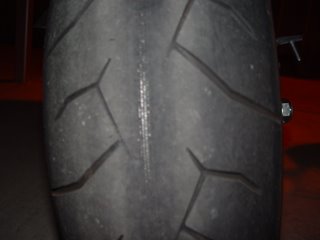
Saturday, October 14, 2006
About friggin time!
It really feels good (emotionally if not physically) to get going on that again. It's been about 3 months now since I was hitting it consistently and my pants are a bit tight :(
It rained Friday and Friday night, so both Friday and today we didn't ride the motorbikes to work. I'm not a sissy about riding in foul weather, but why get soaked and cold when you can drive in comfort? Besides, we hit the first Tule fog this morning. Nasty stuff. There are no wipers on my helmet visor...
Thursday on the way home I really let the bike go. After turning onto a straight stretch of road at about 20 MPH, I opened it up and held it wide open... except at about 70 MPH the wheel was still going up instead of setting back down - so I up-shifted and let it come back down. It damn near wheelied in second gear at 80-90 MPH. Spooky.
Monday, September 25, 2006
Oh dear...
Here's what the CSM had to say: (My comments are in italics)
By Erik Spanberg, Correspondent of The Christian Science Monitor Mon Sep 25, 4:00 AM ET
Many homeowners who scrambled into the arms of an adjustable-rate mortgage over the past few years are now reconsidering their relationship. Adjustable-rate mortgages (ARMs) entice buyers with lower introductory interest rates - sometimes fixed for a limited period of months or years, sometimes not. That rate changes at a designated time based on any one of several indexes.
Simply put, an ARM is attractive to borrowers with spotty credit records as well as those trying to buy a house that's more expensive than they could typically afford. (If you cannot afford it, you cannot afford it. The ARM simply masks this by moving the inevitable higher payments into the future) ARMs can also be a good fit for buyers who plan to live in a house for a limited time.
Whatever the scenario, the adjustable portion of these loans has proved difficult this year as interest rates increased. ARMs account for 25 percent of home loans across the country and the struggles of homeowners are only likely to grow through 2007 as more ARMs reach the adjustment period, analysts predict.
"People who take ARMs are more risk-tolerant," says Doug Duncan, chief economist at the Mortgage Bankers Association in Washington, D.C. (Either that or they fail to understand the level of risk that they are taking) Earlier this month, the MBA reported delinquency rates on home loans for the second quarter of this year. As expected, the percentage of homeowners with ARMs unable to make payments on time increased in comparison with the first quarter of 2006 as well as the same period last year.
In addition, the rate and number of adjustable-loan delinquencies continued to outpace fixed-rate loans by a wide margin. Experts offer several suggestions for ARM-holders feeling the pinch of loans resetting at new, higher rates. Among the options: refinancing to a fixed-rate loan (works if you are not upside-down), negotiating better terms with your current lender (works if your lender is willing), or selling the house and downsizing to a more manageable mortgage (works if housing is selling - which it is *not*), or even renting property for the short term (works if rent more or less covers the mortgage). In short, a lot of people with ARMS may be out of options.
In each case, the key - as in every aspect of financial matters - is preparation. Financial planners and other experts begin each answer with a few words of advice: Take control - fast!
Taking a look at an easy hypothetical mortgage, it quickly becomes evident how difficult the current landscape can be for buyers. For someone who took out a three-year ARM for $200,000 in 2003 to buy a home, for example, the change could go something like this: With a Treasury index, what started with a 4 to 4.5 percent interest rate (stable for three years under terms of the ARM) would have adjusted for the first time this year, likely spiking to 7.5 percent - and adding $400 or so to the monthly payment. (The time to have considered this ARM adjustment was in 2003 - before signing the loan document! Where did people think interest rates were headed from a 50 year low???)
Even with an immediate switch to a fixed-rate mortgage, that buyer would still feel significant pain: closing costs of $3,000 or so (which could be rolled into the new loan) and a fixed rate of 6.5 percent or so would be an improvement, to be sure, but still a significant jump from the introductory ARM rate.
"Before you face that first adjustment, the first thing you need to do is give yourself several months to maneuver and figure out what your options are," says Greg McBride, senior financial analyst at Bankrate.com, a popular personal finance website. "Go pull out your loan documents and see what the index and margins are. It's all spelled out in the documents."
From there, a blizzard of factors and questions must be assessed and answered: How much can you afford? How long do you plan to live in your house? How willing are you to downsize? What is your current lender willing to do for you?
This last point should be analyzed in comparison with other lenders' offers. Experts suggest soliciting rates and terms from three outside lenders to gain perspective on whether the current lender is making a satisfactory offer.
In addition to getting an early head start (Bankrate.com and other sites offer projections and calculators at no cost to help buyers determine what impact an ARM's adjustment will likely have on monthly payments), experts urge homeowners to be realistic in their assessments.
If, for example, you plan on selling your house in a year or so, refinancing would be ludicrous - there would be no chance of recouping the cost.
As for the notion of refinancing a current ARM for a new ARM, forget it. "That's not a good idea, because you're just rolling the dice again," Mr. McBride says. "It's delaying the inevitable, unless you sign a contract with the Yankees or win the lottery." Exactly my thoughts on getting the first ARM
In recent years, ARMs have become more intricate. In part, the lower upfront payments that adjustable loans carry helped spike homeownership to record levels. To spur even more business, the residential real estate industry began offering more complex ARMs, including ones that require only a minimum monthly payment, much like credit cards, as well as mortgages that have the homeowner pay down interest but none of the principal.
In other cases, the terms of the fixed period vary widely. The interest rate may adjust as soon as one month after the loan starts - and keep changing throughout the life of the ARM. "It takes a trained financial person, a trained accounting person, and a trained legal mind to understand some of these mortgages," says Susan Wachter, a former assistant HUD secretary in the Clinton administration. "It's complicated." If it's complicated, that's probably because it's designed to screw you financially - so beware :)
Even a more traditional version with, for example, a two-year fixed rate can cause problems for homeowners when interest rates are on a steady rise, as they have been of late. The reason is simple, as a report compiled earlier this year by the Federal Reserve spells out: Many buyers don't understand how an adjustable mortgage works, which means they're rarely prepared to - or can't - handle unanticipated higher payment schedules.
Even when they do understand the ARM concept, borrowers tend to underestimate the amount by which their interest rates can change, according to Federal Reserve research. A sizable number of adjustable-rate borrowers don't know the terms of their loans at all.
As homeowners consider their options in the face of refinancing their ARMs, it's worth remembering a bit of old-school advice. "We always recommend the fixed-rate mortgage, because you know what your payments are," says Jeff Blyskal, senior editor at Consumer Reports. "And as you move up in your career, it becomes much more affordable."
Sunday, September 24, 2006
Horsepower!
I like that it's quiet, and small as the fairing is, how much of the wind it blocks when you lie down on the tank. On the old bike I was totally exposed and would find myself chilled through at temperatures that aren't currently bothering me much.
Yesterday I left a stop sign and decided to let it wail through first gear at full throttle, and found myself doing a loooong (150-ish ft) low wheelie from 40-70 mph. It didn't last long time-wise (perhaps 1/2 second), but distance-wise, it was a long time to have no steering input. A little scary, but harmless fun, as I was still outside of town in betweeen alfalfa fields.
7.5 seconds to 125 mph. Unreal - at least for me... the motorbike testers were less than impressed with the 2005 Honda CBR1000. Look Here
After riding a co-worker's R6 Yamaha, I have to agree that the weight is a factor in cornering. That R6 is like flinging a bicycle into a curve - no effort. Still, I dig the power (145 HP) and the looks of the Repsol color scheme. Maybe it's a pretender compared to a similar Ducati or Suzuki, but it's certainly potent enough for me!
Wednesday, September 13, 2006
Easy Credit - a revelation
Which leads me to today's musing about easy credit and my inability to recognize it while being slapped in the face by it, hahaha.
My wife loves Home and Garden Television, and watches it religiously. Back in 2002 I recall watching one 'home makeover' program with her in which a couple was renovating their family room with a "budget of $40,000". She suddenly looked at me and asked, "Who has $40k lying around to redo one room of their house?" I said, "I dunno. Maybe they inherited some money." Looking back, I realize that this was my first inkling of what has gone so wrong with our economy. I started to pay more attention to how much money these home-owners were spending on their renovations. In show after show, people who seemed less affluent than I am were spending *way* more money than seemed appropriate for their means.
In my own little slice of paradise (Bakersfield - HA!), more and more people of ordinary means seemed to be able to afford Hummers, Bimmers, Mercedes', and Lexus'. Suddenly everyone was buying new motorboats, RVs, custom rods and Harleys, too.
I didn't understand where everyone was coming up with all this disposable income. It never occured to me that it wasn't 'income' at all, but borrowing. Interestingly I had the opportunity for an early understanding of the great credit bubble, but I failed to grasp the extent of it.
In 2003 (along with most of the rest of the country) I decided to refinance my house. I was interested in a 15 yr mortgage at the lowest interest rate I could get. I ended up paying a couple of points and got a 15yr fixed rate at 4%. Here was my chance for understanding the sudden appearance of Harleys and Hummers in front of oilfield workers homes: The mortgage guy I talked to had asked if I "wanted any cash" or needed to pay off credit cards which I could also tack on to the loan. Having no credit card debt, I answered "no", and thought no further about it.
Fast forward to 2005. I'm two years into paying off my mortgage, and driving a tired (but paid for) 1995 pickup to work. My co-workers had been buying McMansions and new vehicles galore, yet we all earn approximately the same wages. I finally stumbled across a couple of the blogs linked in column to the right and understanding ensued.
What I had apparently witnessed was herd behavior during a massive credit expansion. I had been completely oblivious to the source of the credit (in spite of the mortgage guy's question), while puzzling over the rampant and obvious symptoms.
Fast forward to today. Everyone who wants one has a Lexus, BMW and a boat. They're all "paid for" too! People have the titles to these vehicles in their name. Yet they also have more long-term mortgage debt. Some folks will be paying for these vehicles for 30 years - long after the vehicles are obsolete and the kids have worn them out.
How did individuals in this country become so fearless about taking on crippling levels of debt? Easy credit and low interest rates make it easy to justify taking on debt, but why so much excess? Consider the in-your-face consumption that typifies the 5000 sqft McMansion with matching Hummers in the driveway...
Now, I can see some folks arguing that people taking on long-term debt to finance current consumption may not be all that bad, if it's at historically low rates. In many ways it makes sense to borrow as much as you can at as low a rate as you can. So why can't I shake this deep sense of foreboding about what seems to be such reckless and irresponsible borrowing and spending?
Which brings up another (related) thought: This county has a large military force occupying Iraq. It's an expensive project, because the military contributes nothing to the US economy. On the contrary; a military occupation is a hugely expensive drain on a nation's economy. How are we paying for it, without anyone seemingly having to endure the slightest economic pain - e.g. taxes? The answer, of course, is that the pain has merely been delayed. The war *will* be paid for - not just in blood, but in the overall economy. The US taxpayer, like it or not, will pay for this military action - if not in taxes, in devalued dollars, reduced spending power, and a lower quality of life.
It took 5 years for the economic fallout from the spending debacle in Vietnam and the Great Society to hit the average American, as stagflation took hold. It took another 5 years to recover from it.
Monday, September 04, 2006
My first Honda
First off, I took the month of August off work and pretty much stayed clear of the internet the entire time. I spent the time well, spending a great deal of time with my daughter, and also some with my brother and my mother. I also managed to get in a concert featuring Hinder, Chevelle, Three Day's Grace, and Nickelback.
At the end I found a replacement for Christine, one which I have yet to name. Here's a photo of the bike: (click any photo to enlarge)
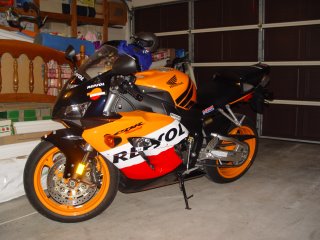
Here's a better photo taken by someone else :)
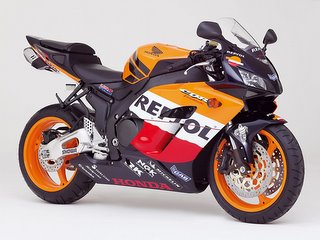
It's really just a CBR1000 with the Grand Prix bike color scheme. Here's the real McCoy, a GP bike with 220 horsepower (note the lack of turn signals, mirrors, and headlight on the racebike).
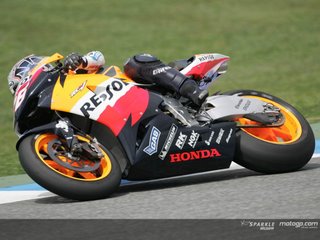
This bike still has *plenty* of power for me. I'm a little bit frightened of it, truth be told. I still don't have the aplomb to let it wail all the way through first gear - it accelerates so fast that it's mind-bending. And yet it's quiet and civilized if you want to ride it that way - as you must, 99% of the time :)
Christine used to go 110 mph on a good day, loud, shaky and full of drama. This bike goes 110 with *no* drama and without even breathing hard. It's incredibly competent at high speed. I suspect it would happily deliver 150 mph without any fuss. I may go out to the desert or a nearby track and find out.
One thing I like about the styling of the machine is that it doesn't have a huge muffler hanging off the right side. Instead it has this very clean undertail exhaust design.
Saturday, July 29, 2006
RIP Christine
Time for a blog update on an old friend (and nemesis) of mine, Christine.
Christine was my last motorbike, a 1979 Kawasaki KZ650. I bought that bike about a year ago from an optometrist in Palm Desert. He wasn't too mechanically inclined, and the bike needed some (more than some!) work, but the bike was fundamentally sound, and the price was right. Fuel cost for driving the truck to work was killing me, and I also just wanted some exhiliration.
So I brought the bike home and started commuting on it. At first I nearly crashed because the rear tire was so worn that it was squared off. As I got comfortable riding it and approached a curvy section of road, it started behaving erratically. First it wouldn't turn enough, then it turned too much! The rear tire was going up onto the "corner" between the sidewall and the flat spot where the tread was worn out. Scary!
After figuring out the handling problem, I decided to remove the rear tire myself and just take the rim into the motorcycle shop for tire replacement. I humped the bike up onto the center stand and pulled all the hardware off to remove the rear wheel. Turns out the bike wasn't up quite high enough to get the rear wheel out from under the fender. So I lifted the bike some more, kicking the wheel while supporting the bike. The bike rolled forward off the center stand, and fell to the ground without a rear wheel under it. On the way the exhaust pipe gouged a nasty gash in my shin, and afterwards it fell against the house, damaging my new stucco job. After telling a friend this story, he said I should name the bike "Christine".
After getting the new tire, Christine handled quite well. Very forgiving, predictable, and manageable. Not too fast though. She was heavy >500 lbs, and not too powerful, at 68 hp. But she was good enough for a commuter bike at 40 MPG - when she ran.
One day on the way home I stopped at an intersection, and when I tried to take off, the engine revved, but the bike went nowhere... like the clutch was pulled in. And I heard an odd metallic clinking sound. Not promising at all... So I picked up my truck and hauled Christine home. The front sprocked retaining nut had come loose and the front sprocket had fallen off the shaft. The metallic noise I'd heard had been the shaft spinning against the sprocket. No big deal - except the bike was down for a week while I waited for the replacement nut/lockwasher, and I was back to driving the 16 mpg F-250 4x4 turbodiesel.
There were a series of events where the bike slowly lost power and then eventually died and left me at the roadside. It was all fuel delivery - I could usually get it to run if I shook the bike around and sloshed fuel in the tank. It always seemed to happen when I was low (less than half a tank) on fuel. It also leaked fuel overnight out the carb overflows. I eventually figured out that the fuel petcock was sticking. It was supposed to open with engine vacuum, and close when the engine shut off. Instead it would stick open when the engine was off, overflowing the carbs. Worse, it would go shut at wide open throttle (low engine vacuum), and wouldn't re-open when engine vacuum returned to normal. It stranded me a lot until I got the petcock issue figured out and repaired.
When my petcock rebuild kit eventually arrived, I repaired the petcock but also decided to clean out the gas tank. I took it to work and ran a lot of water through it to rinse out any sediment, then I blew lots of air through it to drive off any moisture. One of the hoses I used must have been contaminated with something though. When I refilled the tank and started the bike, it barely would run, and it smoked like an old diesel engine. I wasted that entire tank of gas, and another gallon of gas that I used to rinse out whatever solvent or oil had gotten into the tank.
I decided to make Christine more pretty. Got rid of the silly fairing. Added cool blue LED bulbs to the speedo and tachometer. Put LED bulbs in the turn signals after one of them burned out. Replaced the side panels. Polished some of the rustier parts. Fixed a couple of oil leaks. Replaced the aluminum phillips screws with stainless steel allen head screws.
I was able to make her accelerate quite bit faster by advancing the timing and adjusting the points. The points were totally out of adjustment. It's amazing that she was even firing on two of the cylinders.
I bought a shim kit and valve cover gasket with the intention of adjusting the valve clearances - she had a tendency to backfire a bit, and I'm pretty sure that it was from one or more exhaust valve(s) hanging open.
And then the second to the last 'event' occurred. She died on me on the way home from work one morning after night shift. Just bogged down and sputtered to a stop. I realized that she had no juice. None of the lights was on, indicating a charging problem. So I checked the alternator coils and they seemed about right. I bought a rectifier/regulator to replace the seemingly faulty one. No dice.
So I did some further investigation and learned that maybe the alternator coils had a partial short. I ordered an upgraded aftermarket alternator. A nice three phase winding with a full three way bridge rectifier. The stuff took a frigging month to show up to the place I ordered it from. A beautiful riding month during which I was driving a truck with sucky fuel mileage.
While waiting for the parts to arrive, I cleaned the contacts through the ignition switch, as voltage drops through that switch can make the voltage regulator think it's delivering more voltage than it really is, causing its output to go low. Whatever the charging problem was, it was corrected by the new alternator and/or cleaning the ignition switch.
The next day I rode it to work for the first time in a month - and for the last time ever. Sure as heck, the headlight was *way* brighter, as were the gauges.
I was working nights, so the next evening I rode Christine to work (in 104 degree heat), and my riding partner blasted around a truck at 100+ mph, so I did the same.
Shortly after that, she began losing power and pinging a little. I eased off a bit, but it kept slowing down, dragging and dragging, sounding odd. Nothing I hadn't experienced with this bike a hundred times before, right? :)
"Fuel filter", I thought to myself, "I'll check it out when I get to work". I never made it to work. The rear wheel locked up as the engine seized. *Then* the fucking low oil pressure light came on. I coasted to the side of the road - something I've done *way* too many times on this goddam bike - and oil was blowing out the valve cover breather tubes. My riding partner rode off, oblivious!
A co-worker with a truck picked up me and my bike (again) and I spent part of the
night trying to free up the engine with penetrating oil in the cylinders and a 36" pipe wrench on the balancing wheel. Hahaha. I must have slagged it down pretty good, because it never budged.
Ya know I *really* wanted to get a sport bike, but convinced myself to go old and cheap instead. All I got was unreliability and unnecessary toil. Not again. Next time I'm getting a new bike. Right now I need to decide how deep to dig the hole to bury this one :)
There's a picture of me and Christine (back when she was rideable) here
Sunday, June 25, 2006
Burning down the house
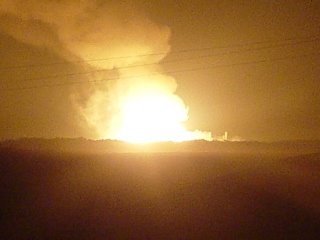
Aftermath. Amazingly no loss of life and only minor injuries occurred.

Cooling tower destroyed. Center of the blaze was apparently just off the frame to the right.
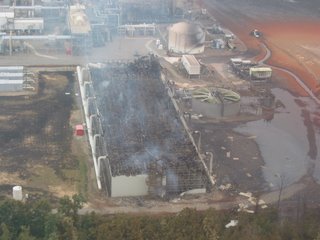
Stuff happens...
Bad day at the power plant
Wednesday, June 21, 2006
Aircraft engine failure
1230 PM, Friday, June 2, 2006 at LAX. XXX Airlines Boeing
767 doing a high power engine run had a #1 engine HPT (high pressure turbine) failure.
The HPT (High Pressure Turbine) failed catastrophically and punctured left wing, #2 engine, peppered the fuselage, and set fire to the aircraft. The turbine disk exited the engine,
sliced through the aircraft belly, and lodged in the outboard
side of the #2 engine. (on the opposite wing of the aircraft)
Choose your seats accordingly :)
Update: Apparently the HP Turbine disks, which were forged from titanium alloy, had incorrect percentages of the alloy materials. This allowed stress cracks to form on the disks, which of course failed under high stress.
Below, part of the failed HP turbine disk, lodged in the engine on the opposite wing of the aircraft.
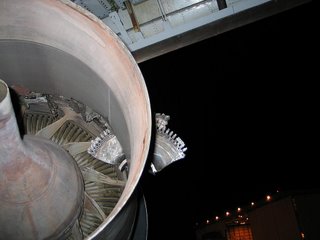
Same description, different angle.

Damage to the aircraft skin. No surprises here - it's basically thick aluminum foil.

Below, the engine that suffered the failure. The compressor section is to the right. The failed disk split the compressor and turbine sections, and of course severed oil and fuel systems. Flame escaped the turbine and the compressor fed the fire with plenty of air. Not sure if the fire supression system was damaged also.

Close-up of the damaged section.
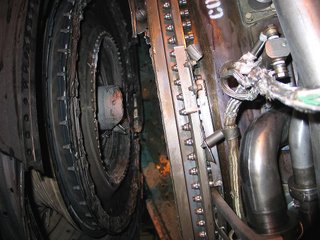
Fire damage aft of the engine.

Scorched paint on the fuselage.
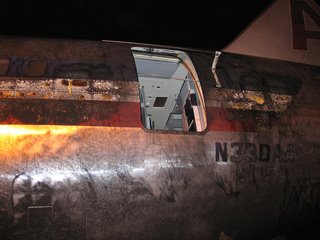
Damaged engine cowling.
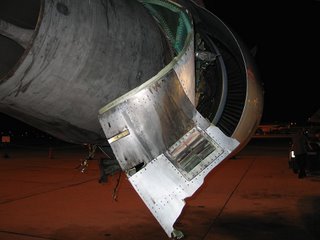
Wednesday, June 14, 2006
Weight lifting
Anyhow here's my routine, for those with interest:
Day 1
Back, Chest, Abs, Cardio
Day 2
Legs and Butt
Day 3
Delts, Abs, Cardio
Day 4
Arms
Day 5 Rest
Repeat ad infinitum.
The eventual goal is to get big and ripped - although it's unlikely as I have the physique of a Kenyan marathon runner (with none of the stamina). So I'll probably have to settle for muscular and fit. Anyway, I'm eating high quality carbs again and very high protein. Time to go do some stair-climbing!
Monday, June 05, 2006
JT8D turbofan
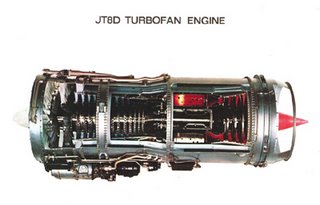
This is a cutaway of the impressive Pratt-Whitney JT8D turbofan. It's an aeroderivative engine used in peaking power plants, and the main competition to the GE LM2500.
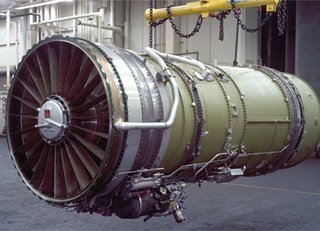
A photo of the inlet end.
These are the engines I alluded to in a previous post that actually produce thrust (actually expanding hot gas) in a power plant environment, rather than shaft output. The engine rests on a stand, with the inlet connected to an air filter by ductwork. The exhaust is directed into a turbo-expander (not unlike a water-wheel arrangement) that converts the expanding gas into rotating energy, with the shaft perpendicular to the direction of thrust. Impressive fact: A single low-bypass aircraft engine can provide about 23 Megawatts of electricity.
Aeroderivative engines are high-maintenance. They are frequently changed out when parts fail on them.
The advantage of this arrangement over the LM2500 is that no alignment is required. The fuel lines, instrumentation and duct work are removed, and the engine can be pulled. Replacement is the reverse. The LM2500 must be carefully aligned with the generator shaft in addition to all of the above items. It lengthens the downtime when failure occurs.
Below: JT8D installation. Looking at the exhaust into the turboexpander.
I have not operated these type plants much at all, but according to co-workers, the JT8D can handle a compressor stall better than the GE machines as well.
Here's a photo of a dual JT8D installation:
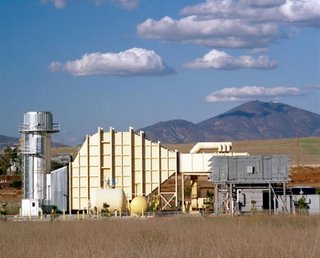
Fascinating early jet engine
I lifted the photo from Wiki, along with the explanation. I'll turn it over to the original author:
"One problem with these early designs, which are called centrifugal-flow engines, was that the compressor worked by "throwing" (accelerating) air outward from the central intake to the outer periphery of the engine, where the air was then compressed by a divergent duct setup, converting its velocity into pressure. An advantage of this design was that it was already well understood, having been implemented in centrifugal superchargers. However, given the early technological limitations on the shaft speed of the engine, the compressor needed to have a very large diameter to produce the power required. A further disadvantage was that the air flow had to be "bent" to flow rearwards through the combustion section and to the turbine and tailpipe.
Austrian Anselm Franz of Junkers' engine division (Junkers Motoren or Jumo) addressed these problems with the introduction of the axial-flow compressor. Essentially, this is a turbine in reverse. Air coming in the front of the engine is blown towards the rear of the engine by a fan stage (convergent ducts), where it is crushed against a set of non-rotating blades called stators (divergent ducts). The process is nowhere near as powerful as the centrifugal compressor, so a number of these pairs of fans and stators are placed in series to get the needed compression. Even with all the added complexity, the resulting engine is much smaller in diameter."
It's impressive that a single stage centrifugal compressor could accomplish the necessary compression to produce enough thrust to fly an aircraft. Then too I've seen home-made turbocharger conversions to turbine engines. They aren't quite this level of sophistication though! :)
Anyway, it's a cool cutaway and I wanted to share it.
Saturday, June 03, 2006
Gas turbine cut-aways and photos
(Click on any image to enlarge)
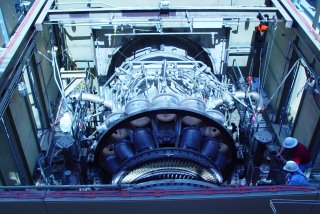
Above is a GE industrial turbine. Note that it is quite large and heavy, and how thick the casing is (bolting for the joints is near the bottom of the photo). Clearly this could never be mounted to an aircraft wing! The air intake is at the far end of the photo, while the exhaust is closest. The mass of smaller pipes is for fuel delivery to the combustors (which have been removed in this photo).
The turbine rotating blades are clearly visible in this picture. The first stage blades are exposed to very corrosive, very high temperature exhaust gas, and are ceramic coated to extend longevity - thus the yellow-ish color. Increasing firing temperatures increases the efficiency of the machines, so there is ongoing research to improve turbine blades. Although it cannot be seen in this photo, the compressor and turbine blades are all mounted on a single shaft that extends throughout the machine.
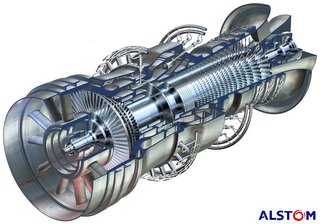
Above is a cut-away drawing of an Alstom industrial turbine. In this rendering, the exhaust is closest to the viewer, and with the cut-away, it is easy to see that the compressor and turbine blades are mounted on a common shaft. Air is drawn in at the far end, compressed, mixed with fuel and burned, and exhausted through the turbine.
This model is unique in that there are two combustion sections. The primary burn section is where the fuel nozzles enter at an angle. The exhaust gases pass through a single stage of turbine blades, then additional fuel is added and burned, and expanded through four more turbine stages. Theoretically in this manner firing temperatures can be reduced.
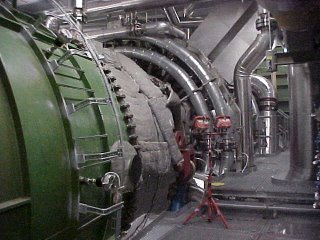
Here is a photo of the above machine.
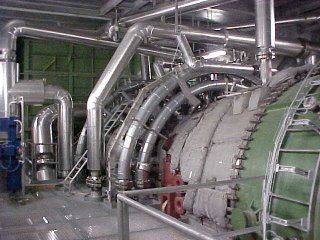
The same machine, from the other side.
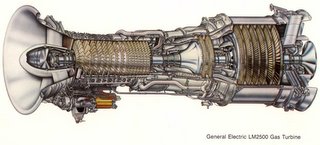
Lastly, here is an example of a commonly used aeroderivative gas turbine,the GE LM2500.
The air inlet is to the left. Air is compressed, fuel added and burned, which turns *two* turbines. This is a two-shaft machine. The first turbine is the high-speed turbine (two stages), which turns the compressor at about 9500 RPM.
The gas is not finished expanding however. It now passes to the second turbine - the power turbine. This second turbine is on a different shaft, rotating at 3600 RPM, which is coupled to an external generator (not shown). The technical term for this is "aerodynamic coupling". Basically the wind exiting the first turbine turns the second turbine.
Monday, May 29, 2006
Memorial Day

First of all, I want to express thanks to the men and women serving our country right now. In particular I want to thank those who are risking their lives daily in Iraq and Afganistan. I make no political statement about these actions, but simply express my gratitude to those serving, and urge them to be careful. It is my hope that they each return home safely to their loved ones.
It's common on Memorial Day to reflect on the servicemen who've given their lives in combat. As an ex-submariner I will be remembering those who died in the dark, cold water in the depths of the ocean. As we say in the silent service, they are on eternal patrol.
Countless men lost their lives in submarines in WWII, from all countries that fielded submarines in the theater of war. We must remember them of course.
But there were cold war losses too, which makes the loss of life more poignant. I want to particularly remember these men, whose lives were offered and taken - not in anger, but in horrific way during peacetime. These men's lives ended when they were forced to endure the worst end that a submarine can bring about. Let us not forget them.
The crew of the Thresher:
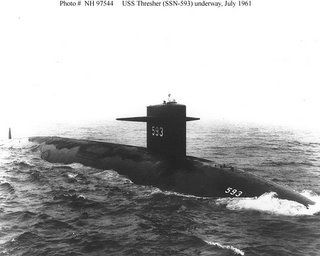
The crew of the Scorpion:

I also want to acknowledge my fellow submariners who lost their lives on the Kursk:
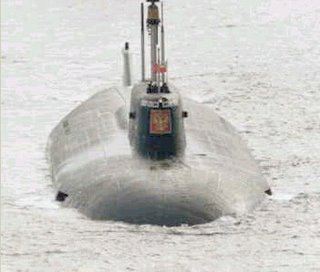
And finally, the crew of Kosomolets:
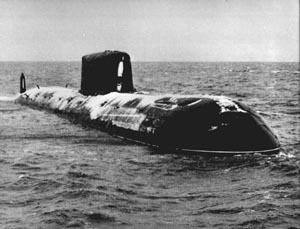
Rest in peace, brothers.
Entering the jet age
Note – small gas turbine power plants and turbine-powered gas pipeline compressing stations have been around for decades. A government/industry collaboration to advance gas turbine technology bore fruit in the late 1990’s. This started a massive building boom in large, highly efficient gas turbine plants.
I started looking around, and eventually was offered a position at a large (1048 Megawatt) facility that was then under construction. I went from burning dirt to operating one of the newest and most advanced gas turbines on the planet :) Fortunately it wasn't too difficult of a change, and being fully automated, it was not as challenging as the coal-burner to operate. I also learned that while gas turbine combustion and control logic are exceedingly complicated, the principle of operation is ridiculously simple. While the principle has been understood for a long time, it's only since WWII that practical gas turbines were actually built.
So how does a gas turbine work? As with coal furnaces, there are two major types that differ significantly from one another, although they both use the same principle, the Brayton Cycle.
Below is a diagram showing the four stages of combustion, both for a piston engine (the otto cycle) and a gas turbine (the brayton cycle). The similarities are that air is compressed, fuel is added and ignited, and work is derived from the expansion of the heated gases. The difference is that the piston engine delivers intermittent power, while the gas turbine compresses, burns, and delivers power continuously.
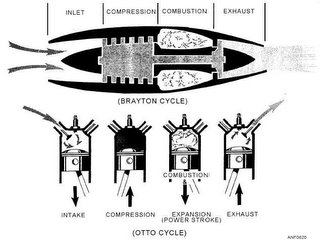
One footnote about the diagram: Most gas turbines used in power generation are not optimized to produce thrust (with one exception that I'm aware of), instead the turbine rotor will have an output shaft that spins at 3600 RPM, turning a generator.
The two types of gas turbines are calle aeroderivative and industrial. It's somewhat self-descriptive, except for the engineering finesse on each design. Aeroderivative engines are gas turbines originally designed for aircraft - they are light, high-revving, easily replaceable machines. In contrast, industrial gas turbines are heavy behemoths that turn at 3600 RPM and are not intended to be removed.
The simpler design, the industrial (or frame) engine, has a single shaft that has an axial compressor at one end, a combustion zone in the center, and a turbine at the exit end. How does it work? The compressor pulls in an enormous mass of filtered air and compresses it. Next, fuel is precisely metered and pre-mixed with the compressed air, and burned in a continuous process. The superheated air expands with great force trough several stages of turbine blades, which convert the expanding gas energy into rotational energy. Because the compressor and turbine are on the same shaft, the turbine provides the energy to drive the compressor, plus has extra power left over to run a generator. The shells on industrial turbines tend to be a couple of inches thick, so that a catastrophic failure will typically be contained within the shell.
In the aeroderivative design there are two rotors. One rotor is high-speed, typically operating at 9500-9700 RPM. This section contains the compressor, combustion zone and a high speed turbine to drive the compressor. In the exhaust path right behind the high speed turbine is a 'power turbine'. The power turbine is connected to a generator that turns at 3600 RPM. As the high speed turbine revs and generates more exhaust gas, the power turbine places more load on the generator. Failures on aeroderivative engines tend to be spectacular - the shells of the engines are light, being designed for aircraft, and when the high speed turbines fail, the blades are thrown at high velocity. Pieces of these turbines are often found outside their protective enclosures following a failure.
The current power plant design is called a "combined cycle" arrangement. In this case we have one or more gas turbines (Brayton Cycle) that operate a generator. The still-hot exhaust gas is then directed into a boiler to create steam and operate a steam turbine (Rankine cycle), increasing power output for the same quantity of fuel burned. Thus we combine cycles! Coupling the cycles yields efficiencies close to 60%. Coal burners and nukes run 30-35% if I recall correctly. Advanced simple cycle (stand alone) gas turbines hit about 40% efficiency.



